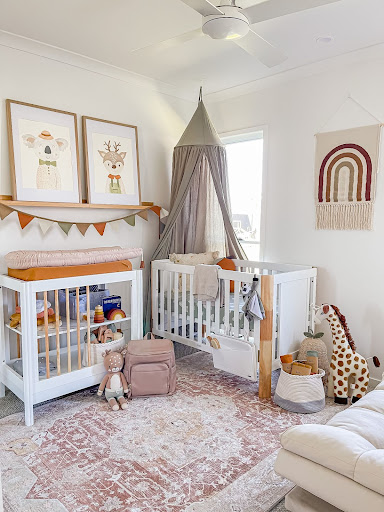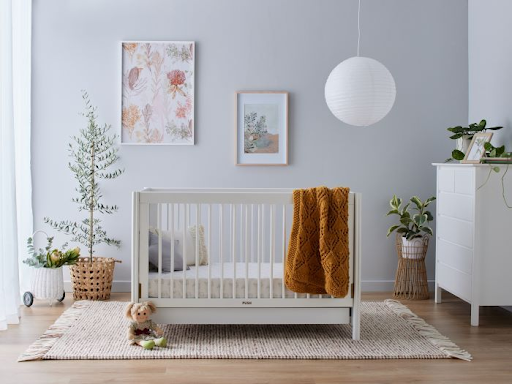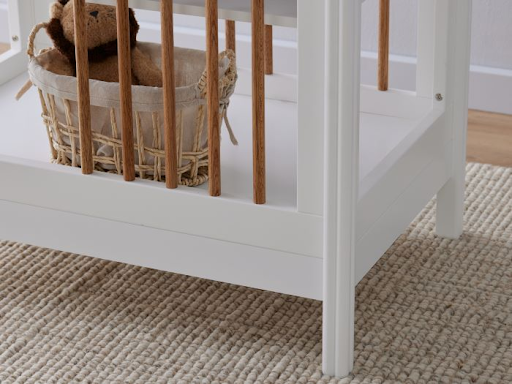When to Transition Your Baby From Bassinet to Cot
For new parents, sleep is precious. In the first few months of life, your child may experience bouts of restlessness contrasted with nights of solid sleep. It's a sleeping pattern that you and the baby will share. As bedtime routines come and go, eventually, you’ll start thinking about a big change: when to move your baby from the bassinet to a baby cot.
The transition can seem daunting, particularly if your baby has started to sleep well in the bassinet, but it also represents an important milestone. While there is plenty of advice out there about when to make the switch from bassinet to cot, it’s important to remember that there is no one-size-fits-all set of rules. There are, however, a few signs that can indicate that the time is right.
Unlike cots, there are no specific safety standards for bassinets in Australia. With no strict guidelines to follow, you should be looking for other signs that it’s time to make the move from bassinet to cot. Consider the following signs:
- Age: Conventional wisdom suggests that babies should transition to a cot when they are around six months old. Every baby is different, of course, but consider six months to be an indication that it’s time.
- Weight: Bassinets will generally have specifically-defined upper weight limits, and, as your baby grows, they will eventually approach that limit.
- Size: Babies should have plenty of surrounding space in their bassinets. If your baby is starting to get cramped in their bassinet, it’s time to move on.
- Motor functions: This is one of the strongest indicators that your baby is ready for a cot. Once your baby shows signs of rolling over or sitting up, the bassinet is no longer suitable.

What You’ll Need Before Transitioning from Bassinet to Cot
Even if your baby is still a little way off sleeping in a cot, it’s worth preparing early. Babies grow and change so much; you might be surprised how quickly your little one becomes ready for a bigger bed. If you’re starting to think about setting up a cot, there are a few things to keep in mind.
A Baby Cot that Complies With Safety Standards
Safety is always a parent’s priority, and it’s helpful to know that there are some strict safety guidelines in place. When you’re looking for a cot, you’ll want to get something that complies with the Australian legal requirements for cots. Look for cots that adhere to Standard AS/NZS 2172:2003, which specifies the required depth, bar spacing, materials and performance of cots in Australia and New Zealand. B2C cots like the Rio Hardwood 2-in-1 are clearly labelled as meeting these safety standards.
Firm Mattress
A firm mattress is very important and, like the cot itself, should be in accordance with the relevant safety standard (AS/NZS 8811.1:2013). Mattresses should fit well - within 20mm of the sides of the cot - and lie perfectly flat. Consider mattresses such as the Baby Innercell Deluxe Mattress, which complies with the standards and is made from firm, high-density foam.

A Good Spot to Put the Cot
A good location for the cot means more than just matching the decor. If your baby has been sleeping in a bassinet in your room or is older than six months, it might be the right time to set them up in their own room. Consider the space around the cot and keep it well clear of windows, heaters and any other potential hazards. If you find the cot takes up more space than you’d like, consider options with additions like a changing table and extra storage.
How to Transition From Bassinet to Cot
Let’s take a second at this point to remind ourselves that moving to a cot doesn’t have to be a single event - it is, after all, a transition. Take things at a comfortable pace, ease into it and remember that what works for some may not work for you.
Once you and baby are ready, here are some ways to approach the big move:
Prepare the Cot
Once you’ve found a safe and snug cot and put it in place, it’s time to make it right for baby. Ensure you’ve got a firm mattress like the Innerspring Latex that fits the cot well, use lightweight bedding that is tightly tucked, and opt for a sleeping bag without a hood.
Switch Gradually
Some babies will sleep like a stone in a new cot, while others might take a little adjusting. It’s okay if you’re in the latter camp - you don’t have to make the change all at once. Consider introducing your child to the new cot with afternoon naps a few days per week.
If your little one has been sleeping in your room, you might find the issue is the change of scenery more than the cot. If you’ve got the space, consider setting up the cot where the bassinet was, then transition to the new room in a few weeks.

Create a Bedtime Routine
Routines can help create a feeling of security, and babies will often respond positively to a regular routine. If you can, ease the transition by repeating the same pre-bedtime steps, such as bathing and reading, followed by snoozing in the cot.
Don't Rush Your Little One
If things don’t take straight away, that’s okay. If you’ve set up the cot and started to make the switch, then it’s fine to take things slow, even if that means going back to the bassinet for the moment. Just like us grown-ups, babies don’t always work to schedule, but you will get there.
Stick Around for a While
When you lay your baby down to sleep in the cot, hang back and let your reassuring presence linger. One technique to try is sitting by the cot until your baby is asleep, then moving a little further away each night until your baby is comfortable sleeping solo.

Ensure the Crib is Comfortable
Comfort is a big reason why it’s important to start with a well-made cot and a high-quality mattress, but it doesn’t end there. It’s not recommended to add stuffed toys or pillows in the first 12 months, but some soft lighting or comforting white noise can be soothing.
Track Their Sleep Patterns With Monitors
If you’re putting the cot in another room, keeping track of your infant with a baby monitor can be a good idea. This way, even when you’re out of the room, you’ll be able to keep tabs on how they’re sleeping.
Bassinet to Cot Transition Tips
Start With Day Naps
Familiarise your little one with their new environment and start with some regular daytime naps in the cot. Then, once they’ve gotten used to it, you can make the move more permanent.
Keep the Right Room Temperature
Where possible, keep rooms at a generally comfortable temperature (around 20-22 degrees Celsius), and dress your baby appropriately. If the room is quite warm in summer, using a fan has been shown to be helpful in regulating the temperature of infants.
Take it Easy
As parents, there are plenty of pressures, both external and internal. Where possible, remind yourself that the move from a bassinet to a cot doesn’t come with a deadline. Take things slowly, go easy on yourself and your baby, and remember that you’ll both get there in the end.
If your baby is just part of a growing family, have a look at some of our other parenting guides, including our Ultimate Guide To Kids Bed Sizes and Are Bunk Beds Dangerous?





